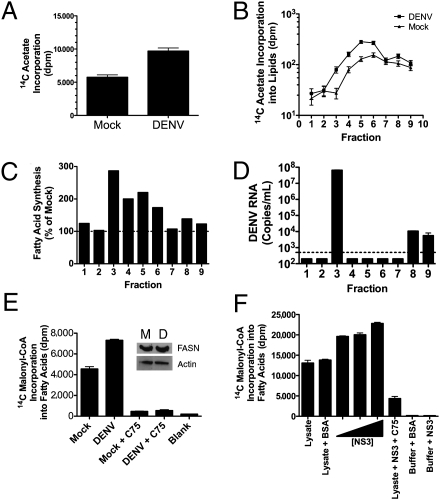Fig. 5.
DENV infection stimulates fatty acid biosynthesis, and de novo synthesized lipids are incorporated into sites of DENV replication. HEL cells were pulsed with 14C-acetate for 4 h, rinsed, DENV- or mock-infected for ∼36 h, and lysed, and the postnuclear fraction of the cells was recovered. The lysate was lipid-extracted and quantified (A) or applied to an OptiPrep gradient (B–E). (B) Lipid extraction of the fractions to determine the amount of radiolabel incorporated into lipids. (C) Percent increase in radiolabel in each fraction from DENV-infected cells compared with mock infection. (D) DENV RNA in each fraction as determined by RT-PCR. The dotted line at 500 copies represents the detection limit of the assay. (E) Cell lysates from DENV- or mock-infected cells were incubated with 14C-malonyl–CoA as a direct measure of fatty acid biosynthesis. The FASN inhibitor C75 was applied to verify that the radiolabel incorporation was attributable to FASN activity. Protein was extracted from the DENV and mock reactions and blotted for the presence of FASN and actin. (F) Huh-7.5 cell lysates were incubated with 14C-malonyl–CoA and increasing concentrations of purified recombinant NS3 (2, 4, or 8 μg) or a corresponding BSA control. C75 (1 mM) was added in parallel to a sample containing NS3. Lipids were extracted, and the radiolabel incorporation was quantified via scintillation counting. The buffer-only control indicates the background of the assay.

